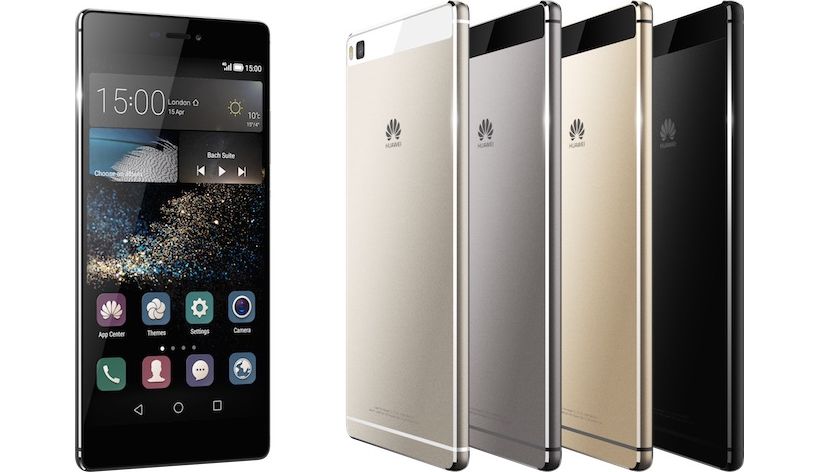
Intro:
Seven years ago Huawei was manufacturing HSDPA modems for Vodafone. It was making smartphones that other companies could brand and then sell. This was its starting point in the most markets.
Today, Huawei is much more than some hardware manufacturer. Its hands are in a multitude of telecommunication businesses. A decade after it was established in 2003, Huawei Consumer BG ranked third in global smartphone shipments in 2013 according to IDC, SA, Gartner.In 2014, Huawei became the first mainland China brand to rank in Interbrand’s Annual Top 100 Best Global Brands Report.
The Huawei, P or rather “ Platinum” or “Premium” series have recorded a steady growth in shipments. Less than four months since its launch the Huawei P8 which is the third in the p series has recorded up to 10,000 units sold daily in the China market.
The Huawei P8 is such an important smartphone as it has becomes the first smartphone from a Chinese company that has had mainstream Western appeal.
Design
Huawei P8 seamlessly brings elegance and comfort together with stunning pieces of technology and in efficiency in mind.
The Huawei Ascend P8 comes with a 5.2-inch full HD display up front, while the metal body design comes in at just 6.4mm thick – making the Huawei P8 thinner than the iPhone 6 and Samsung Galaxy S6.
Picking up the P8, I found it to be well weighted, manageable in one hand and indeed it does look and feel premium. If there is anything that Huawei has been able to keep up with its Ascend P series is the sleekness and ultra-thin design, which is commendable.
The edges are slightly curved, to provide a little extra grip, although the completely flat rear and super slim 6.4mm profile means it’s not the most comfortable to hold. It does however, slip effortlessly in a pocket.
However, compared to last year’s P7, the P8 looks a bit more squared, with the curved edge along the bottom of the P7 now gone.
The square design is echoed in the interesting squared power button, which can be found on the right side of the phone. The metal power lock key is situated about half way down the right of the P8, in a slightly recessed dip making it easier to find when you run a finger along the edge.
While the Huawei P8 does spot a premium metal body, it feels like it has borrowed much of its design from Iphone 5.
The volume rocker sits above it, while below are two trays – one for your 4G nanoSIM and one for a microSD card (up to 128GB in size) which also doubles as a second nanoSIM port.
The charging port also comes at the bottom part of the phone, between two fairly loud speakers. The back part, is stylish with the word Huawei and Huawei logo encrypted at the top part. Huawei has put some effort into making the P8 a decent audio player, and it boasts an onboard Hi6402 DSP for improved audio quality.
You can pick the Huawei P8 up in four colours; mystic champagne, carbon black, titanium grey and prestige gold. The champagne and grey only feature on the 16GB model while black and gold are reserved for 64GB. I got a chance to review the prestige gold, quite pretty I must admit.
By pushing the limits of modern design Huawei has created a harmonious work of art that shines.
Operating System:
The Huawei P8 comes with the latest iteration of Google’s operating system, Android 5.0 Lollipop,.As with all of its Android handsets, Lollipop has been coated in Hauwei’s relatively heavy Emotion UI which does away with the app tray for a slightly more iOS look and feel.
In terms of power Huawei has opted to stick its own Kirin 930 processor inside the P8, and its 64-bit architecture and eight core setup along with 3GB of RAM means it’s more than ready for the demands of today’s applications and games.
P8 also comes with a few extras including an office solution and NQ Anti-virus. There is no app drawer, which means every app is forced on to the homescreen pages, much like an iPhone. The apps can be placed in folders and the homescreens behave like standard Android with moving wallpapers and widgets.
Camera:
There is no better way to tell a story nowadays but through photos.Huawei P8 truly completes a ppackage of stunning phots through a click of the button. The camera comes with a DSLR Level Image Signal Processor, Optical Image Stabilization and a four colour RGBW Sensor.
It seems the R&D department had a lot of research done on the camera of the Huawei P8, with a host of modes and features packed inside this impossibly slender device.
Round the back you’ll find a 13MP camera with dual-LED flash, while on the front you get a decent 8MP snapper – perfect for selfie lovers.
A party trick Huawei introduced with the Ascend P7 and has carried over to the P8 is Instant Shot. It allows you to snap a picture while the handset is locked by double clicking the down volume key.
It even shows up a timer on screen showing you how quickly it snapped the photo – usually 1.1 or 1.2 seconds for me – although you can’t guarantee if your subject is in shot or in focus.
Smartphone camera staples such as full HD video recording and HDR are also present on the Huawei P8, as is an iOS style filter providing you with eight Instagram friendly effects if you want to get arty.
Tap the menu in the top corner of the camera app and you’ll get access to a few more modes including All focus, Watermark and Super night.
All focus is Huawei’s attempt at the now common-place background defocus effect we’re seeing on pretty much every top tier smartphone these days.
Snap a picture with All focus enabled and you can adjust the focus after taking the shot. It’s easy to do, but the blur effect is relatively minor which means the overall appearance isn’t as striking as on some rival handsets.
Watermark allows you to add stickers to your shots – be it your location, the weather or something cheesy like a food related slogan. It’s very reminiscent of the filters you get on Snapchat. You have a limited level of control over them – but I can’t see them getting used all that often.
Super night is for those low-light situations. The Huawei P8 encourages you to keep the handset still, or use a tripod, as camera shake is more apparent here.It doesn’t do too bad a job, and I managed to get a couple of clear night shots with the P8 picking out a decent level of detail.
“Light painting” for four more options; Car light trails, Light graffiti, Silky water and Star track. These rather gimmicky modes are mostly self-explanatory, with Car light trails looking to give you the long exposure shots you see of traffic with the lines of light.
It also comes with the beauty mode and allows one to take panoramic photos.
Another interesting feature is the Director mode which lets you capture the magic of the moment from multiple angles. Then combine footage into your very own professional grade masterpiece.
Battery Life:
The 2600mAh battery is locked inside the aluminium body and can’t be swapped out, but Huawei reckons the P8 will go for a day and a half with normal usage.
With “normal usage” I found the Huawei P8 could see out a day pretty easily, usually ending up in the low teens by the time it came to plugging it in at night. There certainly wasn’t enough left in the tank to get another half a day of use though.
You can fine tune the settings to force particular apps to either stay on or be switched off when the phone is laying idle – again helping you to get the most from the P8’s battery.
There’s also an ultra-power saving mode which strips down the Android OS to a basic six tile, black and white affair, providing access to basic applications only to help you eke out the last drops of life.
The Huawei P8 does heat up a bit after using it continuously for a while, but also cools off immediately.
Media:
The entry level Huawei P8 only comes with 16GB of internal storage, which is pretty low for a flagship these days. However, there is a microSD card slot on the side allowing you to build on the internal offering by up to 128GB.
The 5.2-inch full HD display is handy for video playback, and the P8 comes with a dedicated video application allowing you to locate your moving pictures easily.
Tap a video and you’ll get a basic player, with play/pause, scrub and chapter skip control. It’s all very simple, making it easy to use and the P8 is generally comfortable to hold.
The placement of the speaker at the base of the handset means your hand may be covering it, requiring you to shift your grip of the P8. While it can kick out a decent volume, the quality still isn’t as good as a pair of headphones.
Head over to the music app and it’s another simple affair with songs organised by title, artist and album – plus there’s the option to create playlists.
Sound quality through a decent set of headphones is pleasing, and the internal speaker can fill a room with sound
New feature:
A new feature Huawei has baked into its interface is Speech Awareness. This allows you to say a pre-determined phase for your phone to recognise and then call out to tell you where it is.
It’s not likely to be a feature that’s used all that often, and the ringtone which actually says “I’m here” is a bit odd coming from your phone – but there’s a clear use case for it.
The default ‘name’ given to the Huawei P8 is Emy – not exactly a common name, but you can change it to anything. After setting the name, you have to say the phrase three times into the handset so it can learn your voice, then you’re good to go. Early impressions were positive, saying “Hello Emy” woke the phone up and following that with “where are you” triggered the ringtone and creepy “I’m here” voice.
You can also have the Huawei P8 call someone in your contact book using your voice – but that’s it.
Knuckle Sense Technology.
Basically what this means is the P8 can detect whether you’re tapping the screen with your fingertip or knuckle, and perform a different action depending on which you’re using. Double tap the screen with your knuckle and the P8 snaps a screenshot, while drawing a circle will see a crop tool appear allowing you to select a part of the screen to cut out and save for later.
Price:
The Huawei P8 comes in champagne or grey, costing $529, which translates to Kshs 52,999 on the Jumia Kenya online shop which is around $200 less than most of the competitors, including Samsung, LG, Sony, HTC and Apple.
Verdict:
The Huawei Beautiful design, proficient hardware and a focus on relevant features make it a worthy contender to better recognised brands. Its packaging also is worth noting. Its screen, power, camera and battery life are just about on par with the high-end competition. The Huawei P8 has all the right ingredients for a top of the range smartphone, but something’s not quite gone to plan in the baking. As it is though it feels like a second tier device compared to Apple, Samsung, Sony and HTC – a stigma the firm is still struggling to shrug of




